
|
History of Sex in Cinema: 1934-1937 |


|
L'Atalante (1934, Fr.) Director Jean Vigo's only full-length feature film (and his last film before his death in 1934 at the age of 29) was a poetically-told, lyrical, sensual, visually-rich, sometimes playful drama, and a down-to-earth, simple story about a newly-married couple struggling with and adjusting to their wedded relationship.
After marrying, the two honeymooners lived temporarily on his dingy river barge the L'Atalante. Against stubborn Jean's wishes, the couple temporarily separated and went their separate ways when the bored, capricious and melancholic Juliette went off to window shop and to see Parisian nightlife, while Jean remained on the barge - and then cast off without her, literally deserting her on shore. As they began to miss each other, there was an exquisite and erotic love scene (filmed in a paralleling montage with intercutting and super-imposed images) of the lonely husband and wife restlessly tossing and turning sleeplessly on separate beds (on the barge, and in a seedy Parisian hotel). It has been hailed as one of the most sensual scenes ever filmed.
Each of them was thinking of, desiring and nakedly longing for the other (signaled by self-caressing and fondling). While he arched his back and stiffly sat up on his bed, she placed her hand under her nightshirt to touch her breast.The sequence of erotic desire within their fantasy imaginations was heightened by the editing, that matched up or mirrored their movements to make them appear together and realistically reacting to each other. |
 The Marriage of Jean and Juliette |
||||||||||||

|
Cleopatra (1934) Producer/director Cecil B. DeMille's epic telling of this oft-filmed tale of Cleopatra (1934) featured midriff-bearing Claudette Colbert as the Queen of Egypt's Cleopatra. In the film's opening title screen, a statuesque (naked?) slavegirl held up two incense burners (one in each hand). The alluring, cold-blooded queen would first seduce Roman leader Julius Caesar (Warren Williams), leading him to plan to divorce his wife Calpurnia (Gertrude Michael). His advisors commented about the treacherous Queen of Egypt: "Women soften all men," and "That woman's making an Egyptian out of you."
Then, after Caesar's tragic downfall by assassination, she immediately turned her attention to the dashing Marc Antony (Henry Wilcoxon). She began her seduction of him in the infamous barge/bordello scene which began with decadent entertainment - a prelude to taking him onto her barge to sail off:
The film ended with Cleopatra's famous suicidal bite by an asp placed to her own throat. |
    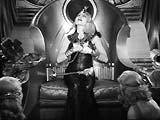 Cleopatra (Claudette Colbert) |
||||||||||||
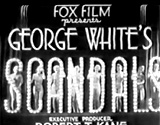
|
George White's Scandals (1934) This pre-Code film starred Fox's resident queen of musicals in the 30s and 40s - Alice Faye, opposite Rudy Vallee (as Jimmy Martin). It was Broadway impresario George White's first film, as co-director, writer, and actor. It was followed by a similarly-titled sequel the next year, George White's 1935 Scandals (1935), in which Faye was top-billed. And then another follow-up film popped up a decade later: George White's Scandals (1945). The platinum-blonde 18 year-old vamp, Alice Faye (in her debut film) was given a major role when the lead actress Lilian Harvey broke her contract and walked out. Faye portrayed vulnerability, sweetness and sultry sexuality in this backstage musical revue film as Kitty Donnelly/Mona Vale, a vivacious aspiring singer with a velvety contralto voice. Her performance was most noted for a lurid and saucy rendition of "Oh, You Nasty Man" with rude lyrics.
Her appearance in the film made her an instant star, and she signed a long-term contract with Fox. |
  Kitty (Alice Faye) |
||||||||||||

|
Hips, Hips, Hooray! (1934) This was an RKO Radio Pictures slapstick comedy musical by director Mark Sandrich. The clever film featured their 1930s famed comedy team of W & W (ex-vaudeville and RKO radio stars Wheeler and Woolsey), at the height of their popularity. They were known for pushing sexual boundaries, witty double entendres (dirty talk), gender role reversals, slapstick and dressing in drag. The two were the "Abbott and Costello" of their time period. The comedy duo of Wheeler and Woolsey also starred in a number of other films from 1930-1937:
In this pre-Code farce, the two played con-men street vendors, typical of their many roles, who decided to assist salesgirl and fashion model Daisy Maxwell (Dorothy Lee) as flavored lipstick salesmen, to help sell her products:
They were hired to favorably impress Maiden America Beauty Products' executive Miss Amelia Frisby (Thelma Todd), Daisy's boss. The risque film opened with a live radio studio broadcast that featured naked models in bathtubs (they were discreetly shielded by foreground products or their hair), as Ruth Etting (Herself) sang "Keep Romance Alive." The sequence proved the old dictum in Hollywood that sex sells. Other bold scenes for their times were ones in which a coin was dropped down the front of a bosomy secretary (with a 'Ka-Ching' sound effect). Also, scantily-clad (bare-backed) girls eagerly offered kisses to the two men, to have them guess their lipstick flavors. One female spun Dudley around for a passionate kiss, causing his legs to slowly rise up and stiffly kick out (symbolic of sexual excitement), after which he remarked: "Public Enemy Number 1."
|
|
||||||||||||
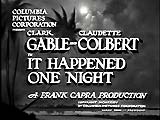
|
Frank Capra's quintessential romantic screwball comedy It Happened One Night (1934) about the battle-of-the-sexes, the first film to take all five top Oscars, starred:
After 1934, the Production Code required that sexuality had to be constrained so films sublimated touchy subjects into other plot elements (use of witty dialogue and repartee). One particularly questionable scene was of the bed blanket separating the two beds of an unmarried male and female (the "walls of Jericho" scene), providing the two co-stars with privacy and respectability. The film mischievously suggested a romantic climax - the walls of Jericho toppled. Gable also made a sexy revelation of his bare-chest under his shirt - the scene reportedly killed the T-shirt industry for awhile. Another of the film's notorious scenes was the 'hitchhiking' technique scene in which Colbert showed off her legs - instantly stopping a passing car. |
 The Walls of Jericho  Bare-Chested Peter (Clark Gable)  Ellie (Claudette Colbert) Hitchhiking |
||||||||||||

|
Men in White (1934) Sidney Kingsley's Pulitzer Prize-winning play in 1934 was adapted into this Code-era story. Because of its illicit romance and suggested abortion, it was condemned by the Catholic Legion of Decency as being "unfit for public exhibition." This gritty slice of life melodrama starred Clark Gable as internist Dr. George Ferguson, a heart specialist who was dedicated to saving lives, and engaged to be married to shallow-minded, headstrong young socialite-heiress Laura Hudson (Myrna Loy), the daughter of a wealthy real estate dealer. He was torn between his relationship with Laura and his opportunity to work with respected Dr. Hochberg (Jean Hersholt). One of the more controversial aspects of the film was the doctor's illicit, one-night stand sexual liaison (after a discreet fade-out) with pretty British student nurse Barbara Dennin (British actress Elizabeth Allan), ending up with her becoming pregnant. She kept the fact of her pregnancy to herself. [Note: Gable began a two-year romance with his married co-star on the set.] The young female patient, after having experienced an illegal, butchered back-alley abortion (or self-induced abortion, or suicide attempt?) to avoid shame, was rushed into emergency surgery. This led to the film's mostly-implied scene related to the abortion (without the explicit use of the word 'abortion' in the film, but alluded to with veiled dialogue about her dangerous condition):
Typical of films at this time, Barbara died following the operation - interpreted as divine retribution for her sexual transgressions. |
  Dr. Ferguson (Clark Gable) with Laura (Myrna Loy)  With Barbara (Elizabeth Allan) |
||||||||||||
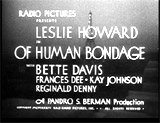
|
Of Human Bondage (1934) In the pre-Code romantic drama Of Human Bondage (1934) by director John Cromwell, there were issues of promiscuity, adultery, a birth out-of-wedlock, naked drawings, and a retributive death from TB/syphilis during prostitution. Bette Davis played the role of blonde, lower-class, slatternly and vulgar, Cockney-accented, illiterate tea-room waitress Mildred Rogers. In the star-making film, she was manipulative, repugnant, exploitative, two-timing, shrewish and cruel toward her weak-willed male benefactor (in "bondage" to her) to which she returned time and time again. She used her sexuality to manipulate the sensitive-minded Philip Carey (Leslie Howard), an aspiring painter and student of medicine. Then, when he expressed interest in going out, she self-centeredly and vindictively berated the crippled, 'hang-dog' Philip with nasty insults for becoming romantically-interested in her. She often gave her disinterested standard response "I don't mind" to him when he would express an interest in her. And at one point, she delivered a stinging blow to dismiss Philip: "Good riddance to bad rubbish" when she exposed the start of her promiscuous affair with loutish, boisterous, womanizing salesman Emile Miller (Alan Hale). Philip could not resist rescuing her and helping her to recover from her failed relationships (her affair with Emile, who deserted her, had resulted in a child). In the hospital, Mildred reacted to the baby: "Funny-looking little thing, isn't it? I can't believe it's mine." Philip's misguided intention was to marry Mildred after her child had been born, but a bored and restless Mildred was a disinterested mother after the baby's birth, and gave up the baby's care to a nurse. In the next instance, Mildred flirted with one of Philip's medical student friends, Harry Griffiths (Reginald Denny), and announced her decision to run off with Griffiths to Paris. Philip became angered and called her "cheap" and "vulgar." She slapped Philip who retaliated and ordered: "Get out! GET OUT!" but it wasn't long before Griffiths told Philip that they had broken up: "Mildred and I are all washed up." Things took a turn for the worse when Mildred moved in (with her baby) with Philip and was at first conciliatory ("You've always been much nicer to me than I deserved. I'm beginning to realize how silly I've been"). She promised to cook for him and clean ("Maybe some day you'll... you'll feel better about me and things will be like they used to be"), but soon things took a turn for the worse; she became very critical and abusive of him - and especially toward his "drawings of naked people" on his mantle, and his coldness to her ("He's not in love with anybody"). In the film's most famous sequence, she attempted to be flirtatious with him in a low-cut negligee, and draped herself next to him, but he pushed her away: "Please get up. You're making a fool of yourself and a fool of me...You disgust me." She viciously retaliated, ending her tirade by calling him a cripple:
She spitefully wrecked his apartment (with his nude drawings and books) and burned the securities/bonds he was given by his Uncle William Carey to finance his medical college tuition expenses, before leaving with her baby. Destitute and forced to quit medical school and vacate his apartment, Philip was fortuitously offered a foot operation to rid himself of his deformity before leaving; although he sought employment, he couldn't find work and became mentally depressed. The film ended with Mildred sick, distraught, unwell, ill (with a deep cough) and destitute (with black circles under her eyes); presumably, she was living as a streetwalker in a dingy brothel, working as a cheap prostitute, although she was portrayed as suffering from tuberculosis (it had been changed from neurosyphilis or locomotor ataxia to satisfy the demands of the Hays Code). She asked: "It's not...me lungs, is it?" Mildred's baby had died the previous summer. Philip gave her some money and a medical prescription, but denied her any other assistance. In the film's last few moments, Mildred was found close to death (the attending medical personnel commented: "Well, this is what you might call the irony of fate"), and she was taken to a hospital charity ward, where Philip learned of her death (from TB or syphilis?). He was liberated and freed at last from his obsessive bondage, to commit to a life of marriage with sweet, tender-hearted 20 year-old Sally Athelny (Frances Dee). He told her:
|
 English Tearoom Waitress Mildred Rogers (Bette Davis)  Mildred's Standard Response: "I don't mind"  Affair with Emile Miller  Mildred's Reaction to Her Out-of-Wedlock Baby  2nd Breakup: When She Admitted Her Interest in Griffiths - Philip Called Her "Cheap" and "Vulgar"  Mildred's Return: Again  Spiteful About His "Naked Drawings"  Wrecking Philip's Apartment (Ripping Up Drawings, etc.) 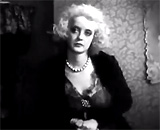 Mildred: Suffering and Dying  Last View of Mildred Close to Death  A Future Marriage with Sally Athelny (Frances Dee) |
||||||||||||

|
The Painted Veil (1934) MGM's soap-opera drama was based upon W. Somerset Maugham's 1925 novel of the same name and set in colonial China. A second film adaptation was The Seventh Sin (1957) with Eleanor Parker, and a more modern third version - The Painted Veil (2006) was made with Naomi Watts and Edward Norton. Early in the film, Austrian spinster Katrin Koerber (Greta Garbo) and her younger sister Olga (Cecilia Parker) shared a lesbian kiss - although it was disguised, due to restrictive Hays Code rules just put into effect, as an intense series of multiple kisses between sisters on Olga's wedding day. |

Katrin (Greta Garbo) and Olga (Cecilia Parker) |
||||||||||||
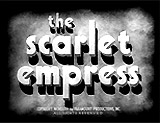
|
This was one of Marlene Dietrich's most frank and suggestive films with director Josef von Sternberg (the sixth of their seven collaborations). The historic film opened with a montage of sado-masochistic, depraved tortures and brutalities in Tsarist Russia, including erotic images and motifs. The images were part of a bedtime story told to young Sophia Frederica (Maria Sieber/Riva, Marlene Dietrich's own daughter). It wasn't censored due to the fact that it was released just before the Hays Code went into effect:
Everything culminated in a dissolve from the human bell-clapper into the hoop skirt of the young empress-to-be on a swing. This stylish, unorthodox and mature biopic showed the development of the character of Russia's Sophia Frederica (Marlene Dietrich), transforming into a sexually-depraved, dominatrix ruler with a whip, even though she was in an arranged marriage with idiotic, grinning, and childlike Grand Duke Peter III (Sam Jaffe in his film debut) - presumably impotent. He was the nephew of unpleasant, domineering Empress Elizabeth Petrovna (Louise Dresser), who only wanted Sophia to serve as "a brood mare" to produce an heir. She experienced many romantic and flirtatious involvements with men in her entourage, mostly with Russian emissary Count Alexei (John Lodge), an opportunistic womanizer and Captain Orloff (Gavin Gordon). Frederica had one of many clandestine meetings with Count Alexei, once in a stable barn, where she seductively kept replacing a piece of straw between her lips and warned: "If you come closer, I'll scream." He removed every strand and then coyly answered: "It is easier for you to scream without a straw in your mouth," before kissing her. She was startled by the whinnying of a horse mid-kiss and ran off. She also met up with an anonymous palace guard, Lt. Dmitri (Gerald Fielding) on his first night of duty, who was astonished to learn who she was: ("If you are the Grand Duchess, then I am the Grand Duke...On a night like this, anything might happen - if I'm fortunate"). She mentioned that he was "very fortunate" and clasped her hands behind him (with extended fingers) as she embraced and surrendered to him - before a fade to black. In a much later scene, she appraised her troops (wearing a fur-hat), with swaggering, flirtatious assertions to Captain Orloff, and then she singled-out Lieutenant Dmitri - another of her attractive, virile soldiers: "Now there's another good-looking soldier....And your duties, Dmitri?...It must be cold at night, sometimes?...Anyway, I'm certain you're very efficient, Lieutenant." She presented him with a medal and pinned it on his chest: "For bravery in action. See that you do justice to it in future emergencies" - he was most likely the one who had borne her a child! She also appeared later that evening with a gauzy veil over herself before allowing Count Alexei to vow his love for her: ("Catherine, I love you, worship you"); when he leaned down to kiss her behind the veil, she gripped the veil with her fist and drew it aside to reveal their affectionate kiss, and then asked for a favor from the scorned Count - to open her secret door for another military figure - Captain Orloff. In the film's bell-ringing conclusion, Catherine (in the white uniform of a male Cossack), with the aid of the military and Captain Orloff had coordinated and engineered a coup d'etat against Peter III and was crowned as Catherine the Great, Tsarina of Russia. The film's last lines were delivered by Count Orloff to Emperor Peter who had been dethroned:
|
 Rotating Wheel  Burning at the Stake   With Count Alexei (John Lodge)   With a Night Guard on Duty  Review of Troops   Again With Count Alexei |
||||||||||||
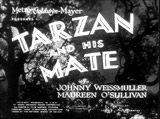
|
Tarzan and His Mate (1934) In this second pre-code, uncensored Tarzan film - Tarzan and His Mate (1934) - a sequel to Tarzan the Ape Man (1932), Jane Parker (Maureen O'Sullivan) had adapted to life in the jungle with Tarzan (Johnny Weissmuller) - as an uninhibited and sexually-free partner who had revealed much of her primitive nature. With the rise of the rigid censorship of the Hays Production Code after this film was made, Jane's scanty clothing and nudity, and rampant sexuality with Tarzan would disappear in future installments. In one of the film's earlier scenes, Jane was tempted to return to civilization with a number of "lovely," "gorgeous" fashionable dresses, hats, shoes, sheer stockings - she was seen nude in silhouette while dressing in the well-lit tent. Through most of the film, she wore only a skimpy, sexy halter top and loin cloth that left her midriff, hips and thighs exposed. One morning in the wild, Tarzan awakened with Jane sleeping next to him in the nude - and coyly told him: "Oh, Tarzan, you're a bad boy." When they went for a swim, Tarzan held onto her dress as he threw her in, and the dress was ripped off her body - she hit the water naked. A nude Jane (body double Josephine McKim, a championship American swimmer who competed in the 1928 and 1932 Summer Olympics) took a skinny-dip swim. She performed underwater somersaults with Tarzan in a scene with beautifully photographed underwater images. Reportedly, there were various versions of the nude scene (nude, topless with a body suit, and with full body-suit), to allow individual states to select the version of the scene which best conformed to its local censorship laws. Later during an attack of a band of lions, Jane's skimpy jungle outfit proved to be very revealing as she knelt down. |
 Jane Parker (Maureen O'Sullivan)  Jane with Tarzan (Johnny Weissmuller)   Jane's Nude Swim 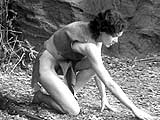
|
||||||||||||

|
China Seas (1935) Platinum-blonde sex goddess Jean Harlow was known for icing her breast's nipples before scenes, and for flaunting her bra-less anatomy. In this romantic adventure film, she took the role of a tough-talking, hot-tempered night-club entertainer (she would have been a loose-living prostitute in the pre-Code days) named Dolly "China Doll" Portland. She portrayed the bawdy mistress of roguish ship Captain Alan Gaskell (Clark Gable). She appeared bra-less in a slinky silk evening dress, which became completely clingy and see-through when ocean-spray-soaked by the storm at sea. |
  
Dolly (Jean Harlow) |
||||||||||||

 |
Forbidden Adventure in Angkor (1935) (aka Angkor, or Forbidden Adventure) Originally a silent 1912 Cambodia documentary (a National Geographic styled-travelogue), this film featured WWI era footage of Cambodia's Angkor Wat shot by two explorers. For its 1935 re-release, it was supplemented with additional footage as an exploitational adventure film with hints of bestiality. It was distributed by Dwain Esper, and shown or exhibited on road-shows (overseen by showman Dan Sonney) as part of a double-feature with Inyaah (Jungle Goddess) (1934). The film, marketed as an expose or jungle adventure-melodrama, documented a trek from a local village into the jungle, on a search for "the forbidden city of Angkor" (once run by apes) with its ancient treasure. In typical fashion for a jungle-trek film, there were many cultural sights, exotic dangers along the way and wildlife - giant monitor lizards, pythons, bats, a killer cobra, monkeys, crocodiles, etc. The additional inserted scenes included those that were shot in Hollywood by George M. Merrick, of topless shots of black LA prostitutes (portraying Cambodian female expedition bearers, played inaccurately by black women) trekking through Topanga Canyon (LA area), who were being harrassed and attacked by an ape-suited man. |
   Topless Female Native Bearers During Expedition  Ape-Suit Man Attacking Native Female |
||||||||||||

|
Legong: Dance of the Virgins (1935) (aka A Story of the South Seas) This mid-30s ethnographic docudrama by French director Henry de la Falaise featured lots of topless native nudity (in the guise of an artful documentary) from an all-native cast. It was filmed in two-strip Technicolor (one of the last), and was often considered the last silent film released in the US by a major American studio (Paramount Pictures). The quasi-docudrama was advertised with the tagline: "TRUE - ACTUALLY FILMED IN BALI", and was accompanied by a poster displaying a bare-breasted Balinese girl. It was banned in many countries, and the non-prurient nudity was excised from the U.S. release, reducing it to about a 30-minute film. The film was eventually restored by combining three versions -- US, British, and Canadian. The film's plot was a tale of unrequited love within a love triangle, between:
The film was typical of a number of exotic Bali pictures released as exploitation or "lecture" films in the early-to-mid-30s following F. W. Murnau's South Seas docudrama Tabu (1931) filmed in Tahiti. For example, the pressbook for the 1930s re-release of Virgins of Bali (Land of Love and Romance) (1932) advertised: "A Land 8 degrees South of the Equator Where the Weather is Hot and So Are the Virgins of Bali."
The narrator of Virgins of Bali (1932) emphasized the film's exploitative content:
|
  Poutou in Legong: Dance of the Virgins (1935)   Virgins of Bali (1932) |
||||||||||||

|
Dracula's Daughter (1936) In this vintage Universal horror classic by director Lambert Hillyer, Gloria Holden played the part of the dark and exotic Dracula's Daughter (aka Countess Marya Zaleska), literally the daughter of Count Dracula (Bela Lugosi). It was remarkable in this Code-era film to have a major character with a kinky (or lesbian) affinity and tormented addiction for the blood of female victims. In one very risque scene for its time, one foggy and cold night, a starving young streetwalker named Lili (Nan Gray) was approached by Zaleska's manservant Sandor (Irving Pichel). The girl was promised "warmth and food and money" at the home of his employer, an artist named the Countess, who paid models to pose for her paintings. Sandor assured her: "There's nothing to fear, come." Once Lili arrived, she met the Countess who again assured her: "Don't be afraid, my dear....Make yourself comfortable, over here." They engaged in an ominous conversation, as the Countess was skeptical about Lili's blood supply as she warmed her hands by a fire: "You have beautiful hands, but they're so white and bloodless." Sandor arrived and Lili was offered a tray holding a sandwich, a bottle of red wine and a wine glass. The Countess explained to the newbie model that she was doing "a study of a young girl's head and shoulders." Lili was asked to prepare by disrobing behind a screen, in order to pose for a painting in front of the fireplace. Lili readied herself by removing her blouse, revealing only a flimsy slip and bra, and then she asked: "I suppose you'll want these pulled down, won't you?" - she pulled down her two straps and was asked to pose by the fireplace to warm herself.
But then Lili became apprehensive:
When Lili refused to go any further, the Countess lustfully approached the hypnotized subject's jugular - the suggestive lesbian scene ended with:
|
   Light From the Countess' Ring Reflected into Lili's Left Eye  An Attempt at Hypnosis  Lili: "I think I'll go, if you don't mind" |
||||||||||||

|
Klondike Annie (1936) Hip-sashaying sex symbol Mae West's earlier hits She Done Him Wrong (1933) and I'm No Angel (1933) established her reputation for bawdy and wisecracking talk. Things would be different, now that the Production Code was in full effect. This film was vigorously censored (or laundered) for its implications of inter-racial sex, representations of torture and unpunished murder, and the immoral character of West as the Frisco Doll - a prostitute/nightclub performer kept by a Chinese lover. |

Frisco Doll (Mae West) |
||||||||||||
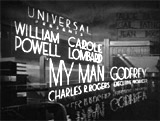
|
My Man Godfrey (1936) My Man Godfrey (1936) was the definitive screwball comedy of the 1930s. Flighty, scatter-brained socialite/heiress Irene Bullock (portrayed by the Queen of Screwball comediennes Carole Lombard) was made to be sexy with daffy sillyness. In the most obvious scene, 'forgotten man' butler Godfrey (William Powell) revived Irene during a faked fainting spell. He hauled the lovesick girl up on his shoulder, carried the limp rag-doll upstairs into her bedroom, deposited her on a stool in the shower and turned on the cold water. She was left soaking wet to the skin in her evening gown. She skipped toward him with hands outstretched, embracing him and exclaiming:
|
 Irene Bullock (Carole Lombard) |
||||||||||||
Love Life of a Gorilla (1937) (aka Kidnapping Gorillas) This little-seen compilation 'educational' documentary from producer Samuel Cummins was an independently-produced jungle exploitation film typical of the 30s. It was inspired after the success of the pre-Code exploitation film Ingagi (1930) about gorilla-worshipping Congolese native women, and after the success of RKO's King Kong (1933). It also was speculated that the film incorporated footage from Ingagi (1930).
The film speculated that there was social/sexual intercourse or matings between African women and gorillas, after a Ubangi maiden was abducted by a gorilla and carried off into the jungle. It was considered scandalous and "off-color" by the Board of Review because of the theme of "the mating of women with wild animals and because of nude figures in the picture." The film included sensational content (ineptly interspersed with horrible stock footage) including a few shots of topless native women (censored versions superimposed fake ferns over bare breasts) and lusty gorillas (men in monkey suits). It was remarkably similar to Ingagi (1930) and to Angkor (1935) (aka Forbidden Adventure) and could have been a heavily-modified re-release with a different title. |
 Captive Native Female |
|||||||||||||

|
They Won't Forget (1937) In a small breakout role in her debut film (with a speaking role), 16 year-old Lana Turner was featured with a sexy, tight-sweatered walk - it made her "the Sweater Girl" and launched her career. In the film, she portrayed teenaged Mary Clay - who was murdered in a school-house in the opening sequence during a Southern town's Memorial Day parade. |

Mary Clay (Sweater Girl Lana Turner) |
||||||||||||